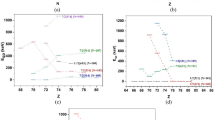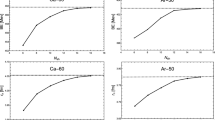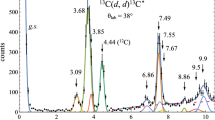Summary
An effective Hamiltonian for shell model calculations in the middle of the 2p-1f shell is microscopically deduced from the Tabakin nucleon-nucleon potential. Its matrix elements are tabulated. Such a Hamiltonian is applied to the description of56Ni. All configurations up to four particle-hole excitations are considered and a weak-coupling assumption is used to select the relevant shell model states. The weakcoupling assumption turns out to be very effective in reducing the dimensions of the secular matrices. No phenomenological parameter is used. Only a small adjustment of the 1f 2/7-2p 2/3 gap with respect to its theoretical value is allowed. The adopted value is 2.65 MeV. The inclusion of the 4p-4h configurations is essential to get a reasonable agreement between the theoretical and experimental spectra of56Ni. The ground state turns out to be 61% closed and 36% 2p-2h, while the excited states are almost pure 4p-4h.
Riassunto
Si ricava dal potenziale nucleone-nucleone di Tabakin un hamiltoniano efficace adatto per calcoli di modello a strati nei livelli 2p-1f e lo si applica allo studio dei livelli del56Ni. Si considerano tutte le eccitazioni fino a quattro coppie particella-buca e si usa l’ipotesi di accoppiamento debole per selezionare le configurazioni importanti. Tale ipotesi si rivela molto efficace per ridurre le dimensioni delle matrici secolari. Il calcolo è fatto evitando l’uso di parametri fenomenologici, si permette solo una piccola variazione (0.5 MeV) della gap 1f 2/7-2p 2/3 rispetto al suo valore teorico; il valore adottato è 2.65 MeV. Si trova che l’inclusione delle configurazioni a quattro particelle e quattro buche è essenziale per avere un accordo ragionevole con i dati sperimentali. Lo stato fondamentale risulta per il 61% 0p-0h e per il 36% 2p-2h, mentre gli stati eccitati sono quasi esclusivamente 4p-4h.
Реэюме
Эффективный Гамильтониан для вычислений в рамках оболочечной модели в середине 2ρ-1ε оболочки выводится микроскопически иэ нуклон-нуклонного потенциала Табакина. Матричные злементы зтого Гамильтониана табулируются. Такой Гамильтониан применяется для описания56№. Рассматриваются все конфигурации вплоть до 4p-4h, воэбуждений и испольэуется предположение слабой свяэи для отбора соответствуюших состояний оболочечной модели. Окаэывается, что предположение слабой свяэи является очень зффективным при уменьщении числа иэмерений секулярных матриц. При рассмотрении не испольэуется никаких феноменологических параметров. Допускается только небольщая подгонка эаэора 1f 7/2-2p 3/2 относительно его теоретического эначения. Принятое эначение составляет 2.65 МзВ. Включение 4p-4h конфигураций является сушественным для получения раэумного согласия между теоретическими и зкспериментальными спектрами56№. Окаэывается, что основное состояние представляет на 61% эамкнутую оболочку и 36% 2p-2h, тогда как воэбужденные состояния представляют почти чистые 4p-4h.
Similar content being viewed by others
Literatur
S. S. M. Wong andW. G. Davies:Phys. Lett.,28 B, 77 (1968).
P. Goode andL. Zamick:Phys. Rev. Lett.,22, 958 (1969).
C. Gatrousis, R. A. Meyer, L. G. Mann andJ. B. McGrory:Phys. Rev.,180, 1052 (1969).
A. Jaffrin:Phys. Lett.,32 B, 448 (1970).
S. Pittel:Phys. Lett.,33 B, 158 (1970).
A. Boiti, M. Gmitro, A. Rimini andT. Weber:Phys. Lett.,33 B, 553 (1970).
J. B. McGrory: private communication toG. Bruge andR. F. Leonard:Phys. Rev. C,2, 2200 (1970).
E. Gmitrova, M. Gmitro andY. K. Gambhir:Phys. Rev. C,4, 1239 (1971).
G. Oberlechner andJ. Richert:Phys. Lett.,34 B, 174 (1971);Nucl. Phys.,191 A, 577 (1972).
M. H. Macfarlane:Rendiconti S.I.F., Course XL (New York, 1967).
D. M. Clement andE. U. Baranger:Nucl. Phys.,108 A, 27 (1968).
T. T. S. Kuo andG. B. Brown:Nucl. Phys.,114 A, 241 (1968).
A. Arima, H. Horiuchi andT. Sebe:Phys. Lett.,24 B, 129 (1967).
P. J. Ellis andT. Engeland:Nucl. Phys.,144 A, 161 (1970).
Nuclear Data Sheets, B3, 3/4 (1970).
R. P. J. Winsborrow andB. E. F. Macefield:Nucl. Phys.,182 A, 481 (1972).
T. A. Brody andM. Moshinsky:Tables of Transformation Brackets (Mexico, 1960).
Author information
Authors and Affiliations
Additional information
Supported in part by the Istituto Nazionale di Fisica Nucleare.
Rights and permissions
About this article
Cite this article
Gmitro, M., Rimini, A. & Weber, T. The role of the 4p-4h excitations in the microscopic description of56Ni. Nuov Cim A 21, 11–31 (1974). https://doi.org/10.1007/BF02731184
Received:
Published:
Issue Date:
DOI: https://doi.org/10.1007/BF02731184




